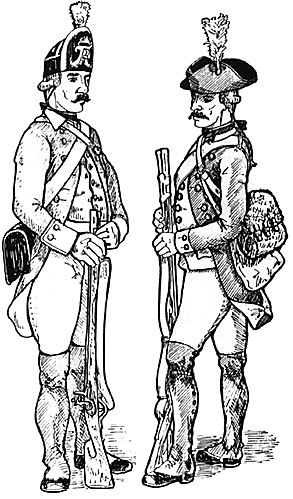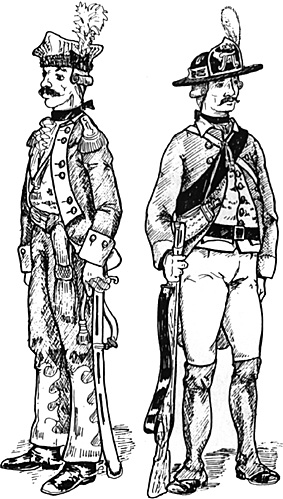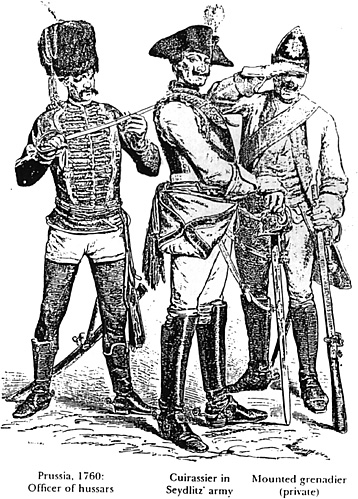 The electoral line of the Dukes of Bavaria became extinct in 1777 with the death of its last
member, Maximillian Joseph. The legal heir to his domains was Charles Theodore, Elector
Palatine, who was pressured by the Austrian Emperor, Joseph II to recognise some old Hapsburg
claims to parts of Bavaria.
The electoral line of the Dukes of Bavaria became extinct in 1777 with the death of its last
member, Maximillian Joseph. The legal heir to his domains was Charles Theodore, Elector
Palatine, who was pressured by the Austrian Emperor, Joseph II to recognise some old Hapsburg
claims to parts of Bavaria.
At right, Jager and soldier from Company von Spitznas.
A treaty was drawn up in Vienna in January 1778 and Austrian troops moved into Bavaria. However, Frederick the Great of Prussia was not prepared to see his old adversary expanding his domains without a fight and encouraged Charles Theodore's heir, Charles Augustus Christian, to formally protest against Joseph's aggression. Prussia was joined by Saxony and Mecklenburg whose rulers also had some claim over parts of Bavaria.
The theatre of war was northern Bohemia which the Prussian armies invaded in July 1778. Joseph had prepared a series of fortified positions along the The river, and well supplied with all the materials of war, sat down to face the allies. As this war saw no battles worthy of the name, Frederick being frustrated at every turn, it has been referred to as the Potato was, this supposedly being the troops main item of diet. During the autumn the Prussians withdrew from Austrian territory and negotiations commenced between the old Empress Maria Theresa and Frederick. With the help of Russian and French mediation, first a truce was arranged and then a treaty of peace agreed upon. Austria gained only the district of the Inn from Bavaria, Prussia some minor territorial acquisitions in central Germany and Saxony a money compensation. Honour being thus satisfied the armies returned to their peacetime stations.
Unusually for Frederick his forces, together with the Saxons outnumbered the Austrians and only a small number of Freicorps' (volunteer units) were raised. They were usually raised by individual officers and strengths varied from single companies to whole regiments.
 At right, Officer, Tartar Corps von Schill and a Jager.
At right, Officer, Tartar Corps von Schill and a Jager.
1. Bischoffswerder Volunteer Jager Corps.
Raised in Saxony in Prussian pay under Major Johann Rudolph von Bischoffswerder with the officers appointed by the King of Prussia.
Strength - 4 companies, in total 17 officers, 48 NCO's, 5 surgeons, 4 musicians and 600 men.
Uniform - Green coat~ straw coloured waistcoat and breeches, silver buttons, leather helmets with white plumes. Black leather belts. Arms: a rifle and bayonet.
(A contemporary newspaper described their passing through Dresden complete with pioneers, ammunition waggons and accompanying women all uniformly green).
2. Volunteer Regiment Count Hordt
Commanded by Lt. Col. Kumpel.
Raised in Swedish Pomerania and Mecklenburg
Strength - 2 battalions
Uniform - not known
3.Volunteer Batallion von Pollitz
Strength - 1 battalion
Uniform - not known
4. Volunteer Batalion von Steinmetz
Commanded by Major d'Elpons
Strength - 1 battalion
Uniform - Dark blue coat, collar, cuffs, waistcoat and breeches light blue. White buttons.
Officers wore silver epaulettes and lace and a hat with wide silver lace. Black cockade and white
feather plume. NCO's had silver lace on the hat with a white plume tipped in black. The soldiers
had black gaiters and a plain white plume on the hat.
5. Volunteer Regiment von Salenmon
Strength -1 battalion
Uniform - as above but with yellow metal buttons and yellow lace in place of silver.
6. Volunteer Regiment De I'Homme de Courbiere
Strength - 1 battalion
Uniform - Blue coat, black facings, white waistcoat and breeches.
7. Volunteer Regiment von Munster
Strength - 2 battalions
Uniform - Dark blue coat with light blue facings, white buttons, silver lace as detailed
above.
8. Volunteer Battalion von Rentz
No details
9. Volunteer Regiment von Stein
Strength - 2 battalions
Uniform - not known
10. Volunteer Battalion von Bremer
No details
11. Volunteer Battalion von Schlichting
Strength - 1 battalion
Uniform - Dark blue coat, facings light blue, white buttons, silver lace as above.
12. Volunteer Jager Company von Spitznas
Strength - 180 men
Uniform - Light green coat, collar and cuffs red, silver buttons. Officers had hats with green cockades, silver epaulettes. NCO's and men had leather helmets. All waistcoats and breeches
white. The soldiers were armed with rifles.
13. Bosniak Squadron Moczydowsky
no details
14. Tartar Corps von Schill
Uniform - Dark blue jacket with yellow collar, lapels, cuffs, epaulettes and buttons. Black
stock. Dark blue trousers with yellow leather decoration. Yellow lace cap with black fur band and
white plume. The lance shaft was coloured blue and yellow as was the lance pennon. Dark blue
saddlecloths with a yellow border (similar to the regular Hussars).
Source
Zeitschrift far Heeres-und Unifornkunde, issues for 1953.

Back to 18th Century Military Notes & Queries No. 3 Table of Contents
Back to 18th Century Military Notes & Queries List of Issues
Back to Master Magazine List
© Copyright 2001 by Partizan Press
This article appears in MagWeb (Magazine Web) on the Internet World Wide Web.
Other military history articles and gaming articles are available at http://www.magweb.com